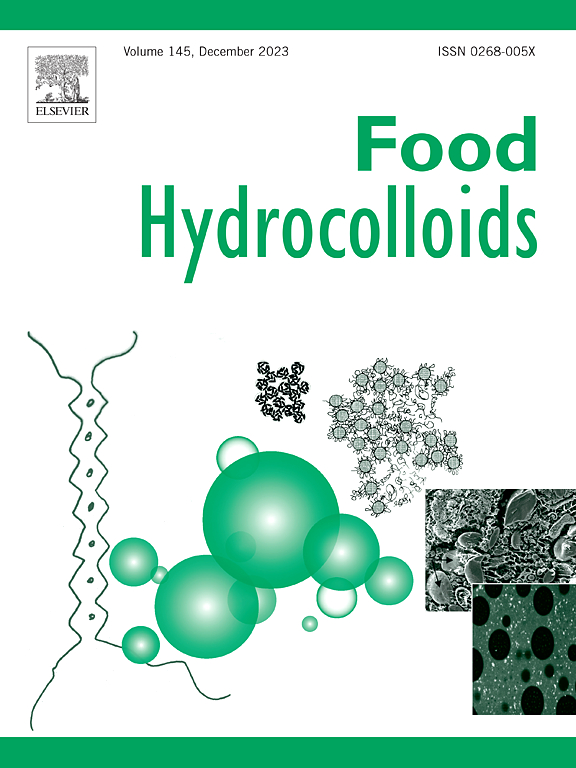智能funoran薄膜结合蓝莓花青素作为双pH/NH3传感器,实时监测虾的新鲜度
IF 11
1区 农林科学
Q1 CHEMISTRY, APPLIED
引用次数: 0
摘要
开发具有腐败检测功能的智能、可生物降解包装材料是提高食品安全和质量保证的一种很有前途的方法。本研究以蓝莓花青素(BBA)为天然pH指示剂,制备了一种呋喃型pH/ nh3敏感智能膜。评价了添加BBA对薄膜理化特性的影响及其对虾鲜度的监测效果。流变性能、ζ电位测量、傅立叶红外光谱(FTIR)和x射线衍射(XRD)分析表明,BBA与呋喃的相互作用是静电相互作用,导致材料复杂的结构网络和晶体结构发生改变。该智能薄膜具有均匀紧凑的结构,在高达100°C的温度下表现出显著的热稳定性。BBA的掺入降低了透光率(78.2% ~ 65%)、水蒸气渗透率(WVP) (8.93 × 10−8 ~ 2.68 g s−1·m−2·Pa−1)和氧气渗透率(OP) (190.98 ~ 132.13 cm3/(m2·day))。相反,拉伸强度(10.83 ~ 14.34 MPa)、断裂伸长率(23.36 ~ 32.05%)和抗氧化活性显著提高。BBA溶液对pH值的变化表现出敏感性,基于呋喃的智能膜(FBA)在不同的缓冲溶液和氨中表现出显著的比色变化。在评估虾的新鲜度时,智能薄膜呈现出实质性的比色变化,特别是在FBA 15%的配方下,在新鲜度检测中表现出优异的灵敏度。这些结果表明,加入BBA的funoran薄膜可以有效地用作食品工业的多功能智能包装。本文章由计算机程序翻译,如有差异,请以英文原文为准。

Smart funoran film incorporated with blueberry anthocyanins as a dual pH/NH3 sensor for real-time monitoring of shrimp freshness
The development of smart, biodegradable packaging materials endowed with spoilage detection functionalities is a promising approach to enhance food safety and quality assurance. In this study, a funoran-based pH/NH3-sensitive smart film was developed by incorporating blueberry anthocyanins (BBA) as a natural pH indicator. The influence of BBA addition on the physicochemical characteristics of the film and its efficacy in monitoring the freshness of shrimp were evaluated. The rheological properties, Zeta-potential measurements, Fourier Transform Infrared Spectroscopy (FTIR), and X-ray diffraction (XRD) analysis indicated that BBA interacted with funoran by electrostatic interactions, which led to alterations in the intricate structural network and the crystalline structure of the involved materials. The smart film exhibited a homogeneous and compact structure, demonstrating significant thermal stability up to 100 °C. The incorporation of BBA reduced light transmittance (78.2 %–65 %), water vapor permeability (WVP) (8.93 × 10−8 to 2.68 g s−1·m−2·Pa−1), and oxygen permeability (OP) (190.98–132.13 cm3/(m2·day)). Conversely, the tensile strength (10.83–14.34 MPa), elongation at break (23.36–32.05 %), and antioxidant activity were significantly improved. The BBA solution exhibited sensitivity to variations in pH, and the funoran-based smart films (FBA) demonstrated notable colorimetric changes in various buffer solutions and ammonia. The smart film presented substantial colorimetric variations while evaluating the freshness of shrimp, particularly with the FBA 15 % formulation, showing superior sensitivity in freshness detection. These results suggest that the funoran film incorporating BBA can be effectively utilized as multifunctional smart packaging in the food industry.
求助全文
通过发布文献求助,成功后即可免费获取论文全文。
去求助
来源期刊

Food Hydrocolloids
工程技术-食品科技
CiteScore
19.90
自引率
14.00%
发文量
871
审稿时长
37 days
期刊介绍:
Food Hydrocolloids publishes original and innovative research focused on the characterization, functional properties, and applications of hydrocolloid materials used in food products. These hydrocolloids, defined as polysaccharides and proteins of commercial importance, are added to control aspects such as texture, stability, rheology, and sensory properties. The research's primary emphasis should be on the hydrocolloids themselves, with thorough descriptions of their source, nature, and physicochemical characteristics. Manuscripts are expected to clearly outline specific aims and objectives, include a fundamental discussion of research findings at the molecular level, and address the significance of the results. Studies on hydrocolloids in complex formulations should concentrate on their overall properties and mechanisms of action, while simple formulation development studies may not be considered for publication.
The main areas of interest are:
-Chemical and physicochemical characterisation
Thermal properties including glass transitions and conformational changes-
Rheological properties including viscosity, viscoelastic properties and gelation behaviour-
The influence on organoleptic properties-
Interfacial properties including stabilisation of dispersions, emulsions and foams-
Film forming properties with application to edible films and active packaging-
Encapsulation and controlled release of active compounds-
The influence on health including their role as dietary fibre-
Manipulation of hydrocolloid structure and functionality through chemical, biochemical and physical processes-
New hydrocolloids and hydrocolloid sources of commercial potential.
The Journal also publishes Review articles that provide an overview of the latest developments in topics of specific interest to researchers in this field of activity.
 求助内容:
求助内容: 应助结果提醒方式:
应助结果提醒方式:


